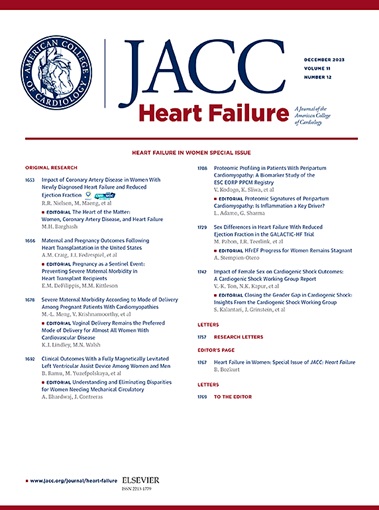左心房-冠状窦分流心力衰竭伴轻度射血分数降低或保留:ALT-FLOW试验(早期可行性研究)2年结果
IF 10.3
1区 医学
Q1 CARDIAC & CARDIOVASCULAR SYSTEMS
引用次数: 0
摘要
背景:ALT-FLOW试验EFS(早期可行性研究)评估了APTURE系统在心力衰竭和射血分数轻度降低或保留患者中的安全性、血流动力学和结果。目的:在本研究中,作者试图检查ALT-FLOW EFS的2年健康状况、功能能力和结果。方法:评估LVEF患者(n = 95)的器械安全性、性能、通畅性、血流动力学、超声心动图参数和结果;评估NYHA功能分级、堪萨斯城心肌病问卷(KCCQ)临床总结评分(CSS)、总症状评分(TSS)、总总结评分(OSS)、6分钟步行距离、运动高峰时肺毛细血管楔形压与体重归一化负荷(PCWL)之比。结果:2.8%的患者在30天内发生了严重的心脏、大脑和肾脏不良事件和再干预。所有植入式分流管的专利最长可达5年。平均PCWL从基线时的131±74 mm Hg/W/kg下降到6个月后的76±57 mm Hg/W/kg (P < 0.0001)。2年后,51/62例患者(82.3%)报告NYHA功能分级改善。基线时平均KCCQ CSS、TSS和OSS分别为45±17、46±19和38±18分,2年后分别提高25±20、26±23和31±23分。PCWL的降低和NYHA功能分级和KCCQ评分的改善在有无肺血管疾病的患者中是一致的。右或左心室功能未见有害变化。结论:在HF和LVEF bbb40 %的患者中,APTURE分流术证实了可接受的安全性,2年后HF症状、生活质量和功能能力得到改善,无论是否有肺血管疾病,都不会对左右心功能产生负面影响。Edwards APTURE经导管分流系统的探索性研究[ALT-FLOW Canada];NCT04000607;edwards APTURE经导管分流系统[ALT-FLOW US]早期可行性研究NCT03523416)。本文章由计算机程序翻译,如有差异,请以英文原文为准。
Left Atrial-to-Coronary Sinus Shunting in Heart Failure With Mildly Reduced or Preserved Ejection Fraction
Background
The ALT-FLOW trial EFS (Early Feasibility Study) evaluated safety, hemodynamics and outcomes for the APTURE system in patients with HF and mildly reduced or preserved ejection fraction.
Objectives
In this study, the authors sought to examine the 2-year health status, functional capacity, and outcomes of ALT-FLOW EFS.
Methods
Device safety, performance, patency, hemodynamics, echocardiographic parameters, and outcomes were assessed in patients with LVEF >40% (n = 95); NYHA functional class, Kansas City Cardiomyopathy Questionnaire (KCCQ) Clinical Summary Score (CSS), Total Symptom Score (TSS), and Overall Summary Score (OSS), 6-minute walk distance, and the ratio of pulmonary capillary wedge pressure at peak exercise to workload normalized to body weight (PCWL) were evaluated.
Results
Major adverse cardiac, cerebral, and renal events and reintervention through 30 days occurred in 2.8% of patients. All implanted shunts were patent for up to 5 years. The mean PCWL decreased from 131 ± 74 mm Hg/W/kg at baseline to 76 ± 57 mm Hg/W/kg after 6 months (P < 0.0001). After 2 years, NYHA functional class improvement was reported in 51/62 patients (82.3%). Mean KCCQ CSS, TSS, and OSS at baseline were 45 ± 17, 46 ± 19, and 38 ± 18 points, respectively, and improved at 2 years by 25 ± 20, 26 ± 23, and 31 ± 23 points, respectively. The reduction in PCWL and improvement in NYHA functional class and KCCQ scores were consistent in patients with or without pulmonary vascular disease. No detrimental changes in right or left ventricular function were observed.
Conclusions
In patients with HF and LVEF >40%, the APTURE shunt confirmed an acceptable safety profile with improvements in HF symptoms, quality of life, and functional capacity without negatively affecting right and left heart function after 2 years, regardless of pulmonary vascular disease. (Exploratory Study of the Edwards APTURE Transcatheter Shunt System [ALT-FLOW Canada]; NCT04000607; Early Feasibility Study—Edwards APTURE Transcatheter Shunt System [ALT-FLOW US]; NCT03523416)
求助全文
通过发布文献求助,成功后即可免费获取论文全文。
去求助
来源期刊

JACC. Heart failure
CARDIAC & CARDIOVASCULAR SYSTEMS-
CiteScore
21.20
自引率
2.30%
发文量
164
期刊介绍:
JACC: Heart Failure publishes crucial findings on the pathophysiology, diagnosis, treatment, and care of heart failure patients. The goal is to enhance understanding through timely scientific communication on disease, clinical trials, outcomes, and therapeutic advances. The Journal fosters interdisciplinary connections with neuroscience, pulmonary medicine, nephrology, electrophysiology, and surgery related to heart failure. It also covers articles on pharmacogenetics, biomarkers, and metabolomics.
 求助内容:
求助内容: 应助结果提醒方式:
应助结果提醒方式:


